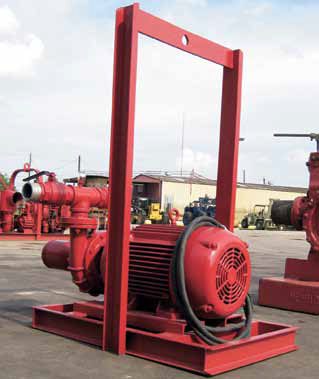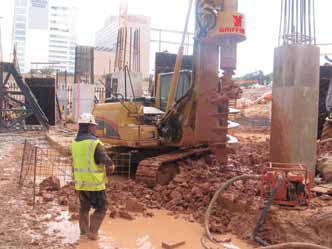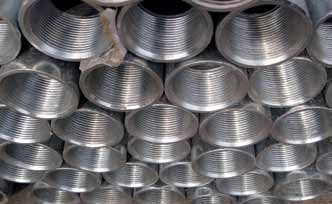When the need for acquiring large equipment and accessories arises, renting could be the right choice.
With the recent influx of money to replace aging sewer systems across the nation as well as heavy flooding from severe weather, rental pumps and their associated accessories have become a hot commodity.
The Decision to Rent
The answer requires that many factors be considered. When making equipment acquisition decisions, many companies are contemplating this alternative to save money and boost their bottom line.
If the needed item will be used on a regular basis, or if a project is of sufficient duration, purchasing the equipment or material may make more sense. In this instance, the company must familiarize itself with what is needed and the options available. Then it is a good idea to compare, purchase, maintain, repair and store the equipment, and the companywill know in what condition the material is and will have immediate access to it. The company will need to have full knowledge of the equipment and experienced personnel onsite to maintain it.
For short-term or irregular use, companies look toward rental houses to fulfill their needs. With a recent increase of companies venturing out of their normal lines of business in search of other new renters, rental companies must have a qualified sales team knowledgeable in all aspects of their products and applications. The rental company will also be up to date on the latest equipment and have heavy-duty equipment as rental equipment that can be put into harsher or less than desirable environments.
The products sound simple enough—pumps, pipes and fittings. What could be so difficult about making this decision? Choose the wrong items, and the work may not be performed or a spill may occur. If a sewer bypass is involved and a spill occurs, the company may make headlines for all the wrong reasons.
Rental houses must now have a vast array of pumps, pipes and fittings to meet the project and must also have a qualified sales force to answer not only the customers' questions but be experienced enough to anticipate and ask for information that the customer needs to provide but might not realize.
The sales person must know the capacity requirements—such as flow capacity (generally in gallons per minute, gpm) and required discharge “head” pressure (generally in “feet of water” or pounds per square inch). The application in which the pump will be used must also be discussed, since all pumps are not created equally and might not be a fit for certain applications.
Choose the Right Equipment
Pumps have come a long way in design, performance and applications. In general, two types of pumps are offered as rental options—above ground centrifugal pumps and submersible pumps, each with specific requirements. A centrifugal pump uses a rotating impeller to increase the pressure (and flow) of a fluid.
Above ground centrifugal pumps are generally used in applications where the suction lift (vertical distance between the centerline of the pump impeller and the surface of the water level) is approximately 25 feet or less. If this suction lift is greater distance, then a submersible pump should be used.
Pump Options
The pumps in this section are the most typical rental pumps. Each type can have a capacity range from a few gallons per minute to thousands of gallons per minute, with suction/discharge sizes from inches to feet in diameter.
End suction centrifugal pump. Although many of the pumps in this section are centrifugal pumps, a request for this type indicates that the customer wants a basic pump and motor (or engine) to pump clean to semi-clean water or effluent. The pump will need to be primed with the use of a hand primer or other filling method and have a foot valve on the suction line. Alternate names for these pumps are booster pumps, jet pumps, ejector pumps or others. Care must be taken to properly select the pumps as the names are generic.
 |
| Ejector pump, an example of an end suction centrifugal pump |
Self priming pump. This pump is similar to the end suction pump. The difference is that this pump will prime itself as long as the volute (pump casing) is full of water. It normally incorporates a check valve on the suction side of the pump to prevent the volute from siphoning out, allowing the pump to prime itself on subsequent start ups.
 |
| Self priming pump in the field |
Self priming trash pump. Similar to the self priming pump, this pump has the capability to pump trash-laden effluent. The trash handling capability is dependent upon the impeller design and size and is usually based on spherical (round) solids.
Dry priming trash pump. This pump, a variation of the self priming trash pump, incorporates a priming device that allows the pump to automatically prime without fluid in the volute. Typical priming devices include compressor/venturi, diaphragm or vacuum units.
The vacuum unit has the largest air handling capacity, therefore being the fastest to prime. In a sewage application, priming time is of vital importance. These pumps will often have an air/water separation chamber in which the air is removed by use of a specialty priming valve connected to the priming system and the fluid is removed by the water pump.
Dry priming, non-clog trash pump. With similar attributes of a dry priming trash pump, this pump incorporates a non-clog impeller design. The use of an enclosed, non-clog impeller, in most cases, improves the efficiency of the pump (allowing for lower operating costs) and the net positive suction head requirement (NPSHr), which provides greater suction lifts versus conventional designs.
Wellpoint pump. This is a specialty pump that incorporates the use of a high air-handling priming system for the continual evacuation of intermittent air resulting in wellpoint dewatering systems.
Special care in selection should be made when renting because typical dry priming pumps may not be suited for this application. The wellpoint pump should generally incorporate a larger air/water separation chamber than those found on typical dry priming pumps. Also, the use of vacuum units is better suited for this application, due to the need to evacuate larger amounts of air than is possible with the use of compressor/venturi or most diaphragm priming systems.
Split case pump. As the name indicates, the pump's case is split on the pump shaft axis and is generally used for high volumes and/or higher pressure applications than conventional end suction centrifugal pumps. While widely used in many applications, many rental houses do not carry this pump.
However, it is a must for applications in which higher pressures are needed, which may require multiple impellers to achieve the higher pressure. This multistage impeller design is not typically possible with conventional end suction pumps.
Submersible water pump. This is a generic term for a pump that is immersed in the fluid that it is pumping. As with centrifugal pumps, they can pump clean water, dirty water or water containing solids. They can be either electric power driven, hydraulically driven or pneumatically driven. The rental project would dictate which pump should be used based on the application involved. As with the above these can range is size and capacity.
Pipe Options
The options included in this section are typical pipes used in the rental market. Some projects may limit the type of material use. This will depend on the application or the makeup limitations.
Steel. Although standard many years ago, steel pipe has been replaced by other types due to the ease of installation and/or weight. Steel is still rented, but mainly in larger diameters for which the other types of pipe are cost prohibited to rent. It may be welded together, coupled with mechanical type couplings, or coupled with specialty ends welded onto the pipe.
 |
| Steel pipes |
PVC. PVC may be rented but will typically be limited to up to 12-inch diameters. This type pipe is generally glued together or may have specialty ends incorporated for re-use.
Aluminum. Being lighter than steel, it is easier to install. Special consideration need to be taken as to the installation and application as the physical properties may restrict the installation, especially in terms of vacuum (collapse) strength.
High Density Polyethylene (HDPE). HDPE is currently the rental pipe of choice, due to its weight, near indestructibility and ease of installation. Typically, this pipe is heat-fused with a rentable fusion machine or can be fitted with specialty coupling ends, which allow for quicker installation without the need for a fusion machine. Special attention needs to be placed on the standard dimension ratio (SDR) rating (relating to the thickness of wall) as it pertains to maximum pressure allowed and/or maximum vacuum rating. Also, HDPE will expand and contract due to ambient temperatures, so this needs to be considered during the layout and installation stage.
 |
| HDPE pipes |
Fitting Options
This section includes a few of the myriad of fittings that may be available for rent and are many times necessary for the proper installation of any pump.
Isolation valve. These valves are used isolate the pump from the pipeline. If a pump must be replaced or removed without shutting down the system, an isolation valve is used. In some instances, these valves are also used to regulate the flow of fluid similar to how one uses a garden hose spigot.
The wider you open, the more flow is allowed. These come in many types—such as gate valves, ball valves and butterfly valves. Special attention should be paid when trash pumps are used. The solids may get caught in valves and affect the valve if the shutting mechanism is in the path of flow, as is the case with butterfly valves.
Check valves. These valves prevent the backflow of fluid. There will be one on any type of pump, whether on the suction side (in the case of self priming trash pumps) or the discharge side (in the case of most other pumps). As with isolation valves, similar precautions should be taken for applications involving trash-laden fluid.
Air release valves. On most installations, air must be released from a pipeline, so the inclusion of these valves is a necessity. Special attention should be paid to the application as not all air release valves are similar in their working parameters. Some will release air with the air under pressure. Others will not, thus allowing for accumulation of air within the piping system that could be detrimental to performance.
Vacuum breaking valves. In some installations, vacuum pressure may have a detrimental effect on the system or materials. These valves allow for the release of vacuum pressure in the pumping system.
Hoses. Similar to the pipe materials described in the previous section, hoses come in a variety of materials (rubber, PVC, nitrile, etc.) that are chosen given the specific needs of each application.
Conclusion
Pumps and their accessories are specialty items. As with any other business, knowledgeable, experienced professionals are the best choice when determining the most appropriate rental equipment for a project. Companies venturing out of their specialty or without the expertise within an application should turn to these professionals so that they can successfully complete their projects on time and without incident.
Pumps & Systems, November 2010

